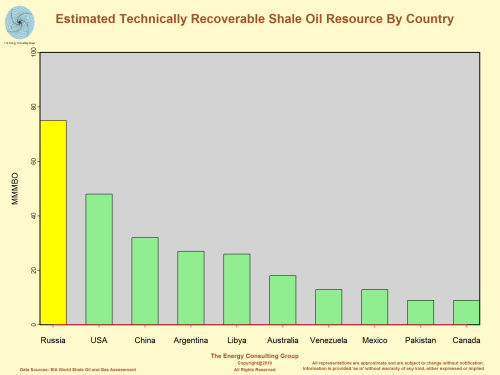The Energy Consulting Group
Business strategy for upstream oil and gas producers and service companies
| Russian Oil and Gas Industry |
|
E&P News and Information Scandinavian International and National International Energy
Agency Department of Trade and Norwegian
Petroleum Ministry of Industry
and E&P Project Information |
|---|
Overview
Russia and
International Oil Companies
Arctic Ocean Pictures
3D Maps
Please contact us at insight@energy-cg.com for more detail.
Russian Oil and Gas Index Map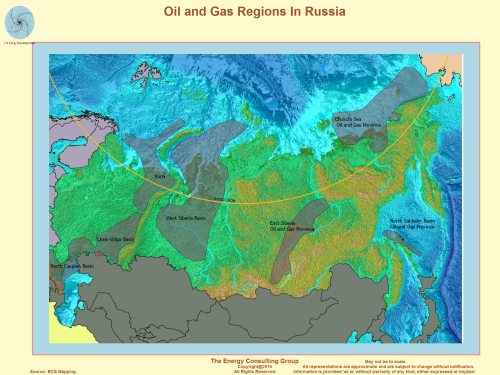 For Higher Resolution, Click Image |
|
|
Estimated Technically Recoverable Shale Gas Potential
For Russia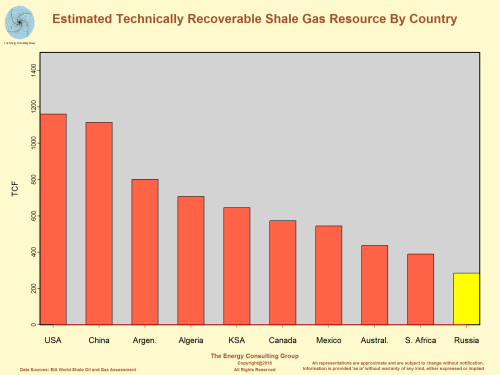 For Higher Resolution, Click Image |
Russian Oil Production, Exports and Reserves For Higher Resolution, Click Image |
|
Russian Gas Production, Exports and Reserves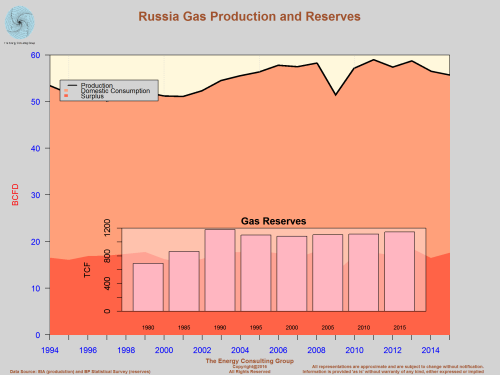 For Higher Resolution, Click Image |
Russia and International Oil
Companies
The Sakhalin 1 JV is producing oil and gas from 3
fields: Chayvo, Odoptu, and Arkutun-Dagi-
located in sub-Arctic conditions off the
northeastern coast of Sakhalin Island in the Russian
Far East. Development efforts at these three
fields are ongoing.
In addition to these
efforts, ExxonMobil and Rosneft are evaluating the
efficacy of adding an LNG export facility to
complement the existing facility that serves the
Sakhalin II joint venture.
One of the more interesting
facets of the Russian oil and gas industry has been the success
that large, integrated international oil companies have had in
making inroads into the Russian oil patch since the dissolution
of the Soviet Union at the end of the 1980's.
Historically, the USSR was not open to allowing western firms to
help them develop its vast oil and gas endowment. However, upon
the dissolution of the USSR, Russia sought western capital and
expertise to help revitalize its oil and gas business, ENI,
Total, Shell, Statoil, BP, and others established upstream
footprints with varying degrees of success. Perhaps no
other firm better exemplifies such efforts than ExxonMobil under
the leadership of Rex Tillerson. As the maps below illustrate,
ExxonMobil has established a wide ranging position, with
potentially enormous reserves and value, in the Russian upstream
oil and gas industry.
Pursuing oil and gas developments in the Arctic Ocean obviously
means successfully navigating sea ice, and protecting the
unparalleled wildlife endowment of the region.
ExxonMobil Involvement in the Upstream Russian Oil and
Gas Sector

For Higher Resolution, Click Image
At the heart of ExxonMobil's
efforts in Russia is its Strategic Cooperation Agreement
(SCA) with Rosneft, the largest of Russia's oil and gas
companies.Of the four initiatives listed on the map to
the left, the one currently producing oil and gas is the
Sakhalin I joint venture with Rosneft at Sakhalin
Island, where the JV is producing large amounts of oil
and gas from the three oil and gas fields.
However, it is the Arctic
Ocean concessions that have the potential to truly "move
the needle" of the type that Wall Street pays attention
to, especially reserves. Rosneft provided
estimates for the 8 acreage blocks that comprise
the ExxonMobil and Rosneft joint venture to
approximatley 210 billion boe of oil and gas resource
potential. Now, we recognize that this estimate is
highly speculative and based on little actual drilling,
so is subject to change (perhaps dramatically so) when,
and if, the JV partners get around to drilling in the
license areas. That said, it does seem to indicate
that Rosneft, and presumably ExxonMobil, believe the
acreage to be highly prospective, potentially extremely
valuable.
Sakhalin Oil and Gas: Phases
I and II
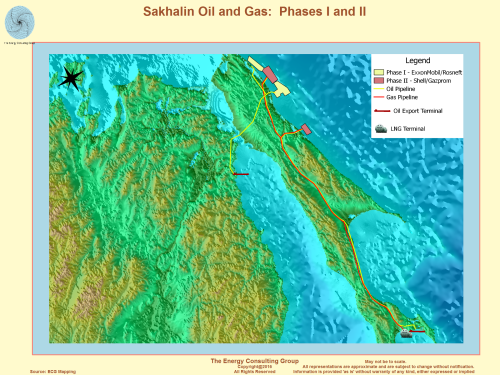
For Higher Resolution, Click Image
Russian Arctic Ocean Licenses Reported As Part of
ExxonMobil/Rosneft JV

For Higher Resolution, Click Image
Rosneft and ExxonMobil Arctic
Ocean Joint Venture
In August 2011, ExxonMobil, the largest western oil
company, and Rosneft signed a deal to develop oil and
gas reserves in the Russian Arctic,
opening up one of the last unconquered drilling
frontiers.
Specfically the deal
encompassed the East Prinovozemelsky (EPNZ) License
Block located in the Kara Sea and with a total area of
126,000 square kilometers (30 million acres).
To hi-light the importance of the deal from a
Russian perspective, it was signed by
Exxon boss Rex Tillerson and Russia's top energy
official deputy prime minister Igor Sechin
in the presence of Russian prime minister Vladimir Putin.
ExxonMobil and Rosneft announced plans to
increase the scope of their strategic cooperation by
adding seven new blocks in the Russian Arctic in the
Chukchi Sea, Laptev Sea and Kara Sea, spanning
approximately 600,000 square kilometers (150 million
acres).
The
combined size of the 8 blocks is large. For
perspective, if the licenses were combined into one and
considered a country, it would be ranked as the 40th
largest country in the world, approaching Turkey in
size.
According to Rosneft, estimated potential recoverable
oil resources in the three
East Prinovozemelsky
subblocks stand at 6.2 billion
tons (about 45 billion barrels) with total potential
hydrocarbon resources at up to 20.9 billion tons of oil
equivalent, which works out to over 600 TCF of gas.
Now, these are huge numbers, which is exciting, but
there are some important caveats. With the exception of
the University-1 well, which resulted in the Pobedo
discovery, it is our understanding that this resource
estimate is based on 2-D seismic only, meaning it is
subject to revisions (potentially very large revisions)
as propects are drilled. That said, if the just
discussed volumes were realized and if average realized
oil and gas prices were respectively, $55/bbl and
$6/mcf, then the total revenue stream could approach
approximately $3 trillion dollars.
The results of the
University-1 well seems to confirm that there is quite
large potential in this block. This well was
drilled in 2014 and the State Reserves Commission
confirmed Rosneft reserve estimates for the Pobeda
discovery of130 million tonnes of oil and 499.2 billion
cubic meters (bcm) of C1+C2 gas, which is roughly
equivalent to 1 billion barrels of oil and 17 TCF of
gas. Still a far cry from the total block
potential discussed above, but nonetheless encouraging
Developing
Oil and Gas Fields in the Arctic Means Dealing with Sea
Ice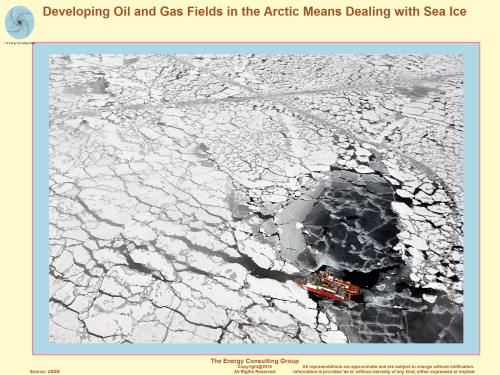 For Higher Resolution, Click Image |
Chukchi Sea: Walrus Herd
Relaxing On An Ice Raft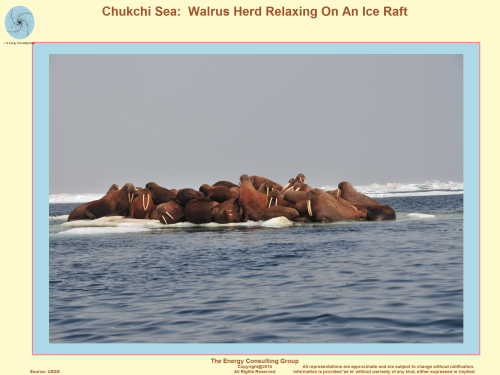 For Higher Resolution, Click Image |
Chukchi Sea:
Walrus Mum and Pup Rest On An Ice Raft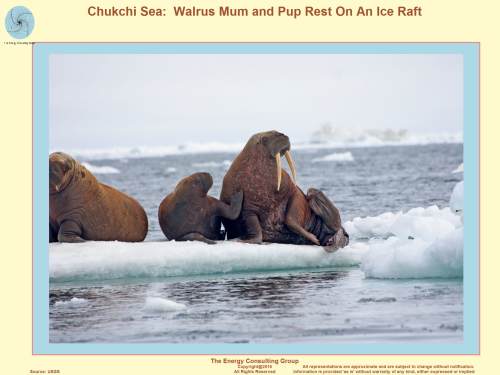 For Higher Resolution, Click Image |
Chukchi Sea: Polar Bear Family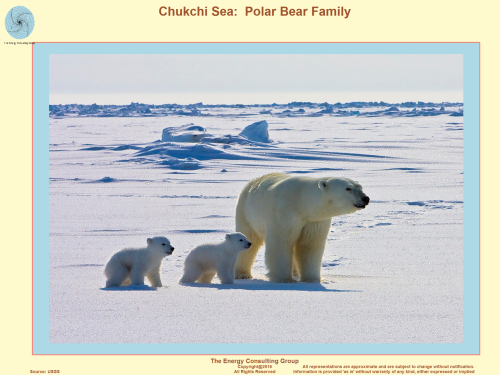 For Higher Resolution, Click Image |
In December 2016, President Obama placed the Arctic Ocean offlimits to new oil and gas leasing. However, this action does not apply to areas outside US territorial waters. A good example of this is the Rosneft-ExxonMobil JV, which includes three acreage blocks just to the west of the US-Russia boundary demarcation. As the map illustrates, the Russian Chukchi JV acreage dwarfs the existing leases in US waters, and the eastern side of these blocks is close to the US-Russian border, raising questions about the effectiveness of the US ban on actually halting or even slowing development of oil and gas resources in the Arctic Ocean.
Comparison of
US and Russian Oil and Gas Leasing in the Chukchi Sea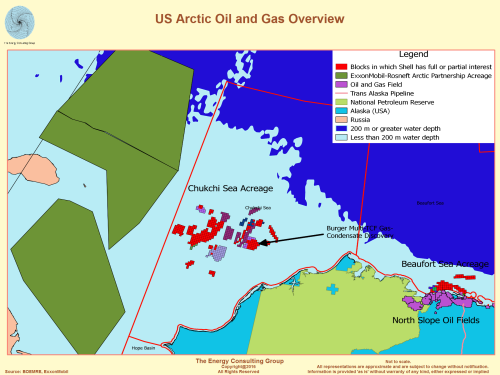 |
|
3D Maps
The following panel contains an interactive 3d elevation map of
Russia's Sakhalin Island.
The Energy Consulting Group home page
